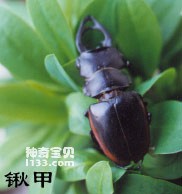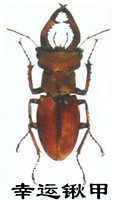The stag beetle is a unique group of branchioceran beetles. It is classified as branchioceran because the 3-6 sections at the end of its antennae extend to one side. It also has elbow-shaped antennae and well-developed upper jaws (teeth) (especially the upper jaw of males). Particularly developed), mostly in the shape of antlers, which distinguishes them from other families. The powerful upper jaw is a weapon of war, it can be said that it is armed with teeth. The body is medium to extra large, with many large species; oblong or oval, dorsally and ventrally quite oblate. The body color is mostly tan, dark brown to black, or has brown-red, yellow-brown and other spots. Some species have metallic luster, and usually the body surface is not hairy. The sexual dimorphism is very obvious. The male has a large head, close to the size of the chest, and the upper jaw is abnormally developed, mostly in the shape of antlers. Male individuals of the same species also vary in size and simplicity due to different levels of development. It is very obvious that the lip base has various forms. The compound eyes are usually small, and sometimes the spine extends to the posterior edge of the eye and divides the eye into upper and lower parts. The antennae are elbow-shaped with 10 sections, and the gills have 3-6 sections, most of which have 3-4 sections and are comb-shaped. Pronotum wider than long. The scutes are well developed. The elytra are well developed and cover the ventral end, and the longitudinal ribs are often not visible or missing. Five webs are visible in the abdomen. The base segments of the midfoot are clearly separated, the tarsal segments are 5-segmented, and the claws are in simple pairs.

The adults feed on leaves, fluids, and honey, while the larvae feed on carrion and live on tree stumps and roots. Adult beetles are mostly nocturnal and have phototaxis, but there are also species that are active during the day. Nearly 800 species have been recorded in the world, and about 150 species have been recorded in my country. Because of their large size and strange shape, they are loved and collected by the public and kept as pets.
1. Lucky Spade Armor
It is a common large species in my country, distributed in Zhejiang, Jiangxi, and Fujian, my country. The male body length is about 40 mm, and the upper jaw is 13 mm long. Sexual dimorphism is evident. The body is chestnut color, and the head and chest are darker. The head is transverse, obviously wider than the chest, nearly rectangular, obviously straight, with slightly concave lateral and posterior edges, protruding front corners, and rounded back corners. The upper jaw is long and incurved, with 2 large teeth, one at the end of the upper jaw and the other at 2/5 of the end. There are 2-4 small teeth between the two teeth, and there are 5 small teeth from the lower teeth to the base. The tentacles are thin and long, with 4 segments. The pronotum is nearly square, with fine particles and engraved spots; the elytra are wider than the thorax, with small engraved spots, and the seams are bright. There are small hairs and fine dots on the lower part of the body. The feet are slender, with reddish-brown vertical stripes on the back of the leg segments of the forefoot and in front of the leg segments of the middle and hind feet; there are 4-6 spines on the outside of the tibia of the forefoot, and 2-3 spines on the outside of the tibia of the middle and hind feet. The color of female insects is similar to that of male insects. The head is small, transverse, nearly square, with engraved points; the upper jaw is curved and short, with a wide tooth at the proximal end. The front and rear edges of the pronotum are nearly straight, the lateral edges are rounded, and the posterior corners are slightly concave; the legs are shorter and thicker than those of the male; the rest are the same as those of the male.

The stag beetle is a unique group of branchioceran beetles. It is classified as branchioceran because the 3-6 sections at the end of its antennae extend to one side. It also has elbow-shaped antennae and well-developed upper jaws (teeth) (especially the upper jaw of males). Particularly developed), mostly in the shape of antlers, which distinguishes them from other families. The powerful upper jaw is a weapon of war, it can be said that it is armed with teeth. The body is medium to extra large, with many large species; oblong or oval, dorsally and ventrally quite oblate. The body color is mostly tan, dark brown to black, or has brown-red, yellow-brown and other spots. Some species have metallic luster, and usually the body surface is not hairy. The sexual dimorphism is very obvious. The male has a large head, close to the size of the chest, and the upper jaw is abnormally developed, mostly in the shape of antlers. Male individuals of the same species also vary in size and simplicity due to different levels of development. It is very obvious that the labial base has various forms. The compound eyes are usually small, and sometimes the spine extends to the posterior edge of the eye and divides the eye into upper and lower parts. The antennae are elbow-shaped with 10 sections, and the gills have 3-6 sections, most of which have 3-4 sections and are comb-shaped. Pronotum wider than long. The scutes are well developed. The elytra are well developed and cover the ventral end, and the longitudinal ribs are often not visible or missing. Five webs are visible in the abdomen. The base segments of the midfoot are clearly separated, the tarsal segments are 5-segmented, and the claws are in simple pairs.
The adults feed on leaves, fluids, and honey, while the larvae feed on carrion and live on tree stumps and roots. Adult beetles are mostly nocturnal and have phototaxis, but there are also species that are active during the day. Nearly 800 species have been recorded in the world, and about 150 species have been recorded in my country. Because of their large size and strange shape, they are loved and collected by the public and kept as pets.
2. Chinese stag beetle
Also known as the stag beetle, it is deeply loved by people for its beautiful and peculiar shape. Its sexual dimorphism and male polymorphism and its little-known living habits are of concern to professionals. The male worm has a body length of 34-79 mm, and the female worm has a body length of 34-48 mm. The body length varies greatly, and males have three types: large, medium and small jaws; the male body color is dark black except for the reddish brown outer edge of the elytra. There are fine particles on the upper jaw, head, and pronotum. The head is quadrilateral, the lateral eye processes are narrow, and there are blunt spines behind the eyes. The pronotum has 2 sharp spines, and the anterior ventral process is spike-like and variable; the elytra are bright black, With a beautiful reddish-brown edge, the upper end of this edge is narrow, and its width rarely accounts for half of the elytra; there are 3-5 fine teeth on the outside of the forefoot tarsi. The female insect is dark black except for the reddish-brown outer edge of the elytra. The width of the head is nearly twice as long as the length, and the upper surface is convex with strong engraved points; the lateral eye processes are very wide; the upper jaw is short, and there are 2 side spines on the pronotum of the thorax. Inscribed points; elytra are black and shiny, with fine inscribed points, and a reddish-brown narrow edge; there are 4-5 spines on the outside of the forefoot tarsi. The larvae feed on dead wood. Distribution: Guangdong, Guangxi, Yunnan, Zhejiang; Vietnam.
animal tags:
We created this article in conjunction with AI technology, then made sure it was fact-checked and edited by a Animals Top editor.